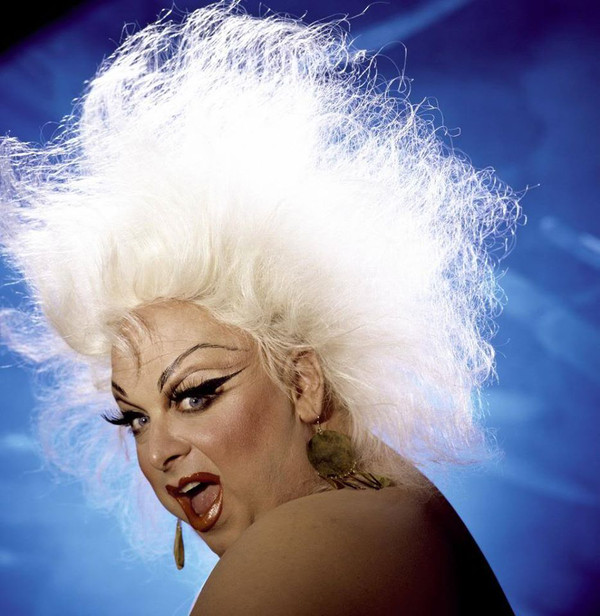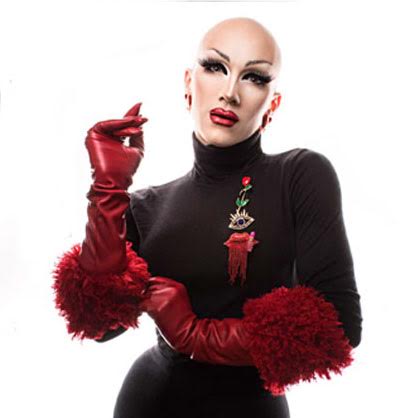Male Gaze and Policing Sexuality
Within the drag scene there are patterns of hyper-sexualizing of the female form and using this as a source of control and power. While sex appeal is not used by all drag artists, it is a popular tactic used to attract an audience and performers generally feed off the audiences’ responses. Sexuality and the performance of sexuality on stage is often policed by audiences who align with heteronormative ideals. Here I examined how sexuality and the female form is used and policed in drag culture.
Male Gaze
In a 1995 Harvard Law Review titled Patriarchy is Such a Drag, the gender binary is addressed as it produces strict categories for what is to be considered as feminine and masculine characteristics. Within Patriarchy is Such a Drag, these rigid boundaries are presented as contributing to the heteronormative ideals reinforced throughout society. Drag Queens often use these feminine gendered ideals and exaggerate them within their performances. One-way femininity is performed by Drag Queens is in a hyper-sexualized way and this is addressed in Shelby Bivins’ 2017 article Nobody Can Drag Me Down. http://mediatedculture.com/2017/03/10/nobody-can-drag-me-down/. Using sex appeal in a performance is common for women artists and for female impersonators because the female form has been historically sexualized and used as a commodity within our capitalist system. This use of the female form is used to attract the male gaze which Nobody Can Drag Me Down defines as a “concept of how media, advertising, literature, and visual arts show women from a masculine point of view, aiming to please men by making women out to be objects (2017).” An article from Feminist Timezhttps://feministtimez.wordpress.com/2016/04/28/blog-post-placeholder-2/ addresses how during Drag Queens’ performances, queens often contribute to the emphasized femininity role portraying a woman according to idealistic views of Western beauty – hour-glass figure, big hair, make-up, and revealing clothing (2012). However, some Drag Artists use this objectification of the female form as a source of power and control during their performance. An example of a Drag Queen who dismantles and works against this ideal of emphasized femininity is Divine who is feature in Filthy Draghttp://dragqueensandgender.blogspot.com/2012/12/filthy-drag.html ; Divine took pride in the ability to surround her performance around opposing emphasized femininity and unrealistic beauty standards (2012). Performances of drag artists offer an illusion and provide a parody of the patriarchal society that has perpetuated sexist, homophobic, and hetero-normative ideals. This system has historically silenced and attempted to erase those who are now holding the power on the stage during these performances. In Keith McNeal’s 1999 article, Behind the Makeup, he explains when a Drag Queen is performed by a gay man, the “femininity” attributed to them is not under stigmatization or ridicule in that moment; instead, this use of femininity is performed in a way that is assertive and combats the standards intertwined with the “hegemonic straight world.”

Image of the Drag Queen Divine who discussed in Filthy Drag. Divine works against the social standards of femininity and expresses a form of femininity that is often unexpected and underrepresented.
Policing Sexuality
In Drag Performances and the Gender Binary, C. Doughtery discusses how even though drag artists are embodying queerness and identity, they may also be making performance decisions that potentially support and mirror hegemonic and normative ideals (2017). Doughtery explains that this can happen because drag artists rely on audience feedback and regulation to adapt their performance styles (2017). This is a form of policing the expression of sexuality is bound together with the hetero-normative ideals embedded in our society (2017). Doughtery addresses how this policing of sexuality is common for drag artists, but the decision to listen to this policing is theirs (2017). In Taylor and Rupp’s 2005 ethnographic piece on the 801 Caberet Girls there is a discussion of the rebellion against the policing of sexuality. An example of this rebellion, discussed by Taylor and Rupp, took place when a drag queen chose to perform a strip tease on stage revealing her antomical body but kept on her wig and makeup (2005). This presentation left the audience with a visual that dismantles the gendered binary and the heteronormative ideals perpetuated by this binary. The performers featured in the 801 Cabaret Girls also made a point to express their belief that sexual acts and actors are more alike than different (2005). These actions and actors only fall differently on the hierarchical scale; the 801 Girls recommend those who fall outside the binary to wear their identities proudly and refuse society’s messages to fit into one category or another (2005). Some drag artists follow this recommendation by avoiding beauty standards while performing or addressing the political importance of being a drag artist. These artists are actively working to dismantle systems of oppression used against women, racial minorites, and those within the LGBTQ community.

Discussing the male gaze was a great choice because it’s very difficult to talk about gender and sexuality without acknowledging the importance of patriarchy. I would like to say that sometimes the hypersexualization serves the purpose to trick the audience into being attracted to a cis-man which exposes the social construction of gender and sexuality in our heteronormative culture. Still, you made really goods point about the beauty myth and body ideals that I agree with.
I really like how you covered the topic of the male gaze and policing sexuality coming from both sides! The female body is hypersexualized in our capitalist society and drag queens are dismantling that by their performance as a woman with the stereotypical female body that is so overly sexualized in today’s society. With that being said, one could argue that drag queens are only feeding into the stereotypical and hypersexualized female. Great post, very thought provoking!
I like that drag queens like Sasha Velour are getting their moment. The term realness also plays into this factor, I feel like. Because passing as a real woman is held to such a high standard, sexualization of women will play a big role.